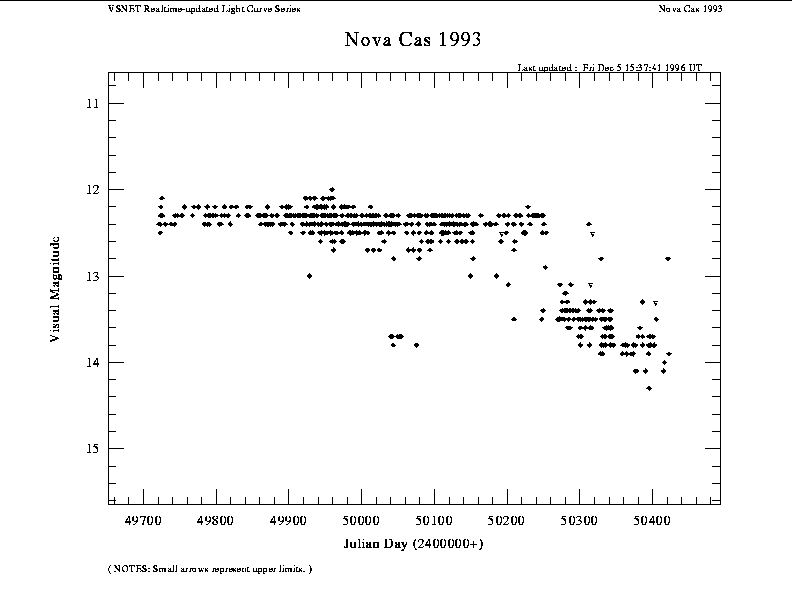
(vsnet-obs 2963, R. J. Bouma)
Fading of V705 Cas (Nova Cassiopeiae 1993)
Observations by Dutch amateurs over the last 9 month or so clearly show that V705 Cas is slowly fading from its secondary maximum near magnitude 12.1 that lasted for almost a year, roughly from mid 1994 till mid 1995. We have summarized our observations since September 1 1995 in the table below. We have been puzzled by some recent observations published in the VSNET-observations, that have V705 Cas still as bright as magnitude 12.3, while our last observations of June 15.0 were near magnitude 13.4. We suspect that the recent magnitude 12.3-12.5 observations are NOT of V705 Cas, but of nearby GSC 4008.1363, listed as magnitude 13.05 (+/- 0.40), but that one of us (BMU) estimated at about 12.5 on June 15.0. This star is easily identified as the brightest of a small triangle SSW of V705, if the field is viewed under sufficient magnification. Therefore, we suggest that observers take extra care when making future observations. We welcome your comments on this issue.
Observations of V705 Cas: Date Mag code 950901.82 12.4 BMU 950902.95 12.3 BMU 950905.95 12.3 FJH 950917.86 12.3 BMU 950917.93 12.3 FJH 950920.85 12.4 BMU 950928.82 12.4 BMU 951001.86 12.3 FJH 951005.78 12.5 BMU 951018.77 12.3 FJH 951020.78 12.4 BMU 951021.79 12.4 BMU 951023.75 12.6 CMG 951023.78 12.4 BMU 951024.76 12.4 BMU 951025.77 12.5 BMU 951025.99 12.4 FJH 951028.19 12.5 BMU 951029.76 12.4 BMU 951030.75 12.4 BMU 951030.95 12.5 FJH 951102.17 12.4 BMU 951113.77 12.3 BMU 951113.78 12.6 FJH 951119.84 12.6 FJH 951120.76 12.4 BMU 951125.77 12.3 BMU 951125.95 12.7 FJH 951126.74 12.4 BMU 951214.96 12.6 FJH 951215.73 12.4 BMU 951220.93 12.7 FJH 951224.78 12.5 BMU 951228.94 12.5 CMG 960105.83 12.8 FJH 960108.78 12.6 BMU 960115.77 12.9 FJH 960122.77 12.8 FJH 960123.74 12.5 CMG 960201.77 12.9 FJH 960206.76 12.9 FJH 960307.79 12.9 CMG 960308.85 13.2 BMU 960309.82 13.1 BMU 960310.83 12.9 CMG 960420.08 13.4 BMU 960505.89 13.5 BMU 960612.98 13.5 BMU 960614.96 13.4 BMU 960515.03 13.4 FJH 960615.0 13.4 CMG
Comparison stars: 118, 125, 131 and 133 of AAVSO-chart 2/94 (PEP(V) of Lowell Obs.). NOTE: Visually the sequence looks better if 131 and 133 were reversed. They were used as given on the chart, however.
Observers: BMU - R.J. Bouma, Groningen, The Netherlands, 25.4cm Jones- Bird Reflector. CMG - Georg Comello, Roden, The Netherlands, 28cm SC. FJH - Henk Feijth, Goutum, The Netherlands, 30.5cm Refector. -------------------------------------------------------- Reinder J. Bouma email: rjbouma@pi.net Bekemaheerd 77 phone: +31 (0)50-5418227 9737PR Groningen Netherlands --------------------------------------------------------
VSNET real-time light curve

I agree in that observers should take special care in identifying the nova, but I am tempted to present another explanation. Novae during this stage usually show forbidden emission lines of [OIII] 495.9 and 500.7 nm. Sometimes the contribution of these lines to visual magnitudes may be so large that the sensitivity of the individual eye to these emission lines may determine the visual magnitude. Since these lines are located in relatively blue region, sensitivity of the eye to these lines changes dramatically depending on the degree of dark adaptation. Dark-adapted eyes are more sensitive to these lines. Such effect was very clearly demonstrated in previous novae like QU Vul etc. During the "nebular" phases of these novae, there were discrepancies up to 1 magnitude. Even the same observer gave different magnitudes through eye-pieces of different magnification, which probably affected the dark-adaptation through the surface brightness of the background sky. Does anyone have a similar experience? I also welcome further comments.
Regards,
Taichi Kato
